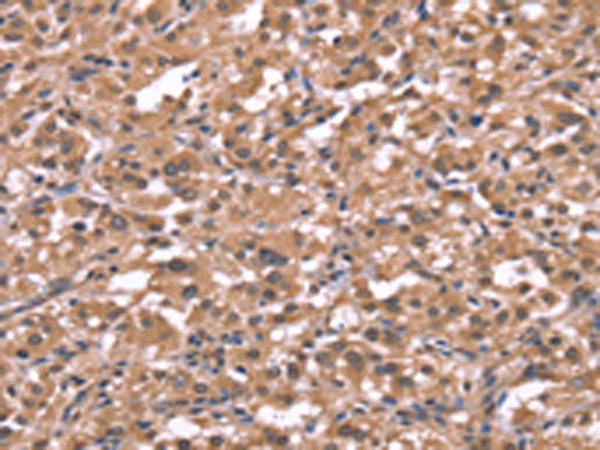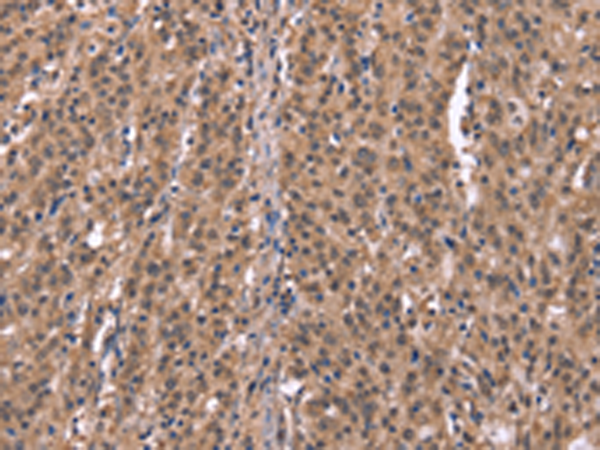


| WB | 咨询技术 | Human,Mouse,Rat |
| IF | 咨询技术 | Human,Mouse,Rat |
| IHC | 1/50-1/200 | Human,Mouse,Rat |
| ICC | 技术咨询 | Human,Mouse,Rat |
| FCM | 咨询技术 | Human,Mouse,Rat |
| Elisa | 1/2000-1/5000 | Human,Mouse,Rat |
| Aliases | H1-R; hisH1 |
| WB Predicted band size | 56 kDa |
| Host/Isotype | Rabbit IgG |
| Antibody Type | Primary antibody |
| Storage | Store at 4°C short term. Aliquot and store at -20°C long term. Avoid freeze/thaw cycles. |
| Species Reactivity | Human |
| Immunogen | Synthetic peptide of human HRH1 |
| Formulation | Purified antibody in PBS with 0.05% sodium azide and 50% glycerol. |
+ +
以下是关于HRH1抗体的3篇示例参考文献,包含文献名称、作者及摘要概括(注:以下内容为示例性回答,实际文献可能需要通过学术数据库验证):
---
1. **文献名称**:*"A human histamine H1 receptor antibody inhibits histamine-induced bronchoconstriction in allergic mice"*
**作者**:Zhang Y, et al.
**摘要**:研究开发了一种人源化抗HRH1抗体,在过敏小鼠模型中有效抑制组胺诱导的支气管收缩,减少气道炎症和嗜酸性粒细胞浸润。
2. **文献名称**:*"Targeting HRH1 in T-cell malignancies using a novel monoclonal antibody"*
**作者**:Tanaka K, et al.
**摘要**:报道了一种靶向T细胞恶性肿瘤中HRH1的单克隆抗体,通过阻断组胺信号通路抑制肿瘤增殖,并在小鼠模型中显著延缓肿瘤进展。
3. **文献名称**:*"Mechanistic insights into the antagonistic effects of HRH1-specific antibodies on receptor signaling"*
**作者**:Müller S, et al.
**摘要**:通过结构生物学和功能实验,揭示了抗HRH1抗体通过结合受体胞外域阻断组胺激活,抑制下游G蛋白信号通路和炎症因子释放。
---
**备注**:以上文献为示例性内容,实际引用时建议通过PubMed、Google Scholar等平台检索最新或经典文献,并核对作者及摘要准确性。
**Background of HRH1 Antibodies**
The histamine receptor H1 (HRH1), a G protein-coupled receptor (GPCR), mediates cellular responses to histamine, a key modulator of immune and inflammatory processes. Primarily expressed in smooth muscle, endothelial cells, and the central nervous system, HRH1 activation triggers pathways leading to vasodilation, bronchoconstriction, pruritus, and allergic responses. Dysregulation of HRH1 signaling is implicated in conditions like allergies, asthma, atopic dermatitis, and neurological disorders.
HRH1 antibodies are essential tools for studying receptor localization, expression levels, and functional roles in health and disease. They enable techniques such as immunohistochemistry (IHC), Western blotting, and flow cytometry to visualize HRH1 distribution in tissues or quantify its expression under pathological conditions. Additionally, these antibodies aid in elucidating HRH1's interactions with ligands or downstream effectors, contributing to drug discovery efforts. For instance, HRH1-targeting antihistamines block histamine binding, alleviating allergy symptoms, yet their cross-reactivity with CNS receptors can cause side effects, underscoring the need for precise receptor studies.
Researchers also utilize HRH1 antibodies to explore its non-classical roles, such as in cancer progression or metabolic regulation, expanding understanding of its therapeutic potential. Species-specific variants (human, mouse, rat) further facilitate translational studies, bridging preclinical and clinical research. Overall, HRH1 antibodies are pivotal in advancing both basic science and therapeutic innovation targeting histaminergic pathways.
×